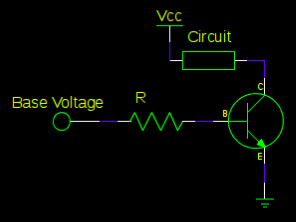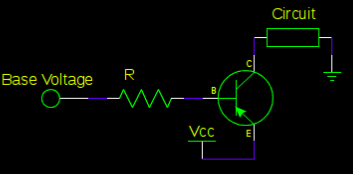NPN and PNP Transistors
NPN and PNP TransistorsIntroduction
Transistors are incredibly useful devices. My favorite use for bipolar junction transistors (BJTs) is switches. By either applying a high (1) or low (0) voltage to them, the transistors switch from on to off or vice versa. These transistors also can be used for current amplification. They can also be used along side diodes to create logic gates. However, this will focus on the difference between the NPN and PNP transistors.
How to choose between the NPN and PNP transistors
The two transistors can be used to perform the same thing, such as switching, but how to use them differs. Below I explain how both the NPN and PNP function and then depending on your application, you can choose whichever transistor is more applicable.
NPN Transistor

NPN transistors flow current from the collector to the emitter. Generally, the emitter is grounded and the circuit that will be powered on and off is put on the powered collector side of the transistor. It should be noted that although the top part of the circuit may be connected to a voltage, no current actual runs through the circuit until it is connected to ground, which is separated from the circuit by the NPN transistor. The NPN transistor is on when there is a high voltage (1) connected to the base and off when there is a low voltage (0 - generally ground) connected to the base. It is also important to know that the voltage on the base pin is connected to how the transistor is connected in the circuit. The base pin voltage in this configuration is ground, which is likely due to the grounded emitter pin. This is why when the NPN transistor's base pin is then connected to a high voltage, such as 5V, current flows into the transistor and connects the emitter and collector.
PNP Transistor

PNP transistors flow current from the emitter to the collector. Generally, the emitter is powered and the circuit that will be powered on and off is put on the collector side of the transistor connected to ground. It should be noted that the circuit will once again not be powered unless the transistor is in the on position. The PNP transistor is on when there is a low voltage (0 - generally ground) connected to the base and off when there is a high voltage (1) connected to the base. In the case of the PNP transistor, the voltage on the base pin is approximately what the Vcc voltage is. When I tested this with a 5V Vcc, the base pin voltage was approximately 4.6V. This is why when the PNP base pin is connected to ground, current will flow to the transistor, which connects the emitter to the collector.
Cautions
When working with transistors as with all components in circuits, care has to be taken to analyze how the current flows through the circuit. With transistors, it is a little trickier since there are three pins rather than two like with resistors and capacitors. However, as stated previously, they are very useful components. If something is not working the way you expect, I have found that there is generally current flowing into or from a base pin unintentionally.
For a more thorough discussion visit here.